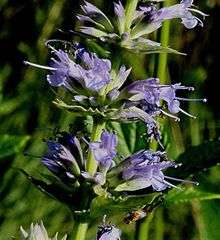Agastache scrophulariifolia
| Purple giant hyssop | |
|---|---|
 | |
| Agastache scrophulariifolia | |
| Scientific classification | |
| Kingdom: | Plantae |
| (unranked): | Angiosperms |
| (unranked): | Eudicots |
| Order: | Lamiales |
| Family: | Lamiaceae |
| Genus: | Agastache |
| Species: | A. scrophulariifolia |
| Binomial name | |
| Agastache scrophulariifolia | |
Agastache scrophulariifolia, also known as the purple giant hyssop, is a perennial plant that grows throughout the US and Northern Ontario, CN. It is a beneficial plant to pollinators and is noted for its medicinal properties, as many plants in the mint family are. It tends to grow in disturbed or open areas where it does not have to interact with non-native competitive plants.
Description
Individuals of this species are perennial herbs that can grow up to six feet tall. They are late-flowering species in the mint family. Agastache scrophulariifolia tends to have several spiked inflorescence. Flowers of Agastache scrophulariifolia do not all bloom simultaneously and range from lavender to pink in color. The dark brown fruit they produce is a nutlet.[1]
Distribution
Agastache scrophulariifolia was once distributed throughout CT, DC, DE, GA, IA, IL, IN, KS, KY, MA, MD, MI, MN, MO, NC, NE, NH, NJ, NY, OH, PA, SC, SD, TN, VA, VT,WI, WV, and ON, Canada. However, its range is now severely reduced in many areas and in some cases extirpated completely. These declines are largely due to habitat loss, predation by deer, and competition for resources with non-native plants.[2]
Conservation status in the United States
It is listed endangered in Connecticut [3] and Massachusetts, as threatened in Maryland and Vermont, and as a special concern in Kentucky and Tennessee.[4]
Habitat and Ecology
Agastache scrophulariifolia tends to grow in riparian habitats, disturbed open areas, and meadows. The previously mentioned areas are ideal for Agastache scrophulariifolia because competition with other plants is reduced. As riparian habitats are altered or farmlands return to forest communities, Agastache scrophulariifolia suffers from habitat loss. It is a perennial plant that grows well in sandy loamy soils and requires sunlight for its seeds to germinate.[2]
Usage
Many people use this plant for its aromatic effects. Its leaves are edible. [5]
Medicinal
The Meskwaki use an infusion of the root as a diuretic, and also use a compound of the plant heads medicinally.[6]
References
- ↑ Corrigan 2002, p. 2.
- 1 2 Corrigan 2002, p. i.
- ↑ "Connecticut's Endangered, Threatened and Special Concern Species 2015". State of Connecticut Department of Energy and Environmental Protection Bureau of Natural Resources. Retrieved 3 February 2018.(Note: This list is newer than the one used by plants.usda.gov and is more up-to-date.)
- ↑ "Plants Profile for Agastache scrophulariifolia (purple giant hyssop)". plants.usda.gov. Retrieved 3 February 2018.
- ↑ Midwest Foraging: 115 Wild and Flavorful Edibles from Burdock to Wild Peach By Lisa M. Rose
- ↑ Smith, Huron H. 1928 Ethnobotany of the Meskwaki Indians. Bulletin of the Public Museum of the City of Milwaukee 4:175-326 (p. 225)
- Corrigan, Elizabeth E. (2002). "Agastache scrophulariifolia (Willd.) Kuntze Purple Giant Hyssop Conservation and Research Plan" (PDF). New England Wild Flower Society.
Plants Profile for Agastache scrophulariifolia (Purple giant hyssop). Plants Profile for Agastache scrophulariifolia (Purple giant hyssop). Retrieved May 5, 2014, from http://plants.usda.gov/core/profile?symbol=AGSC
PURPLE GIANT HYSSOP Agastache scrophulariifolia (Willd.) Kuntze. Retrieved May 5, 2014, from https://plants.usda.gov/plantguide/pdf/pg_agsc.pdf